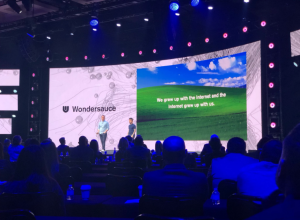John Sampogna talks about his journey in setting up Wondersauce.
Know My Team
My role at Wondersauce, and how I got here.
We started Wondersauce in 2011 with the dream of creating an agency that was completely focused on human behavior and how that impacts design, technology, marketing and media. We believe the world is getting smaller and agencies need a holistic understanding of all facets of the modern marketing funnel. At any given time we are creating global ecommerce platforms, producing content across all mediums, recommending how brands can use technology to transform their organization, and also planning and buying media. To say the least, all days are different and exciting.
https://twitter.com/ericmayville/status/826789144781275136
As a CEO in a heavily tech-loaded ecosystem, what draws you to explore more about technologies for marketing and advertising?
Simply put, we have no choice. Relevancy is king and we need to ensure anything our clients customers are seeing are personalized as contextual to the situation they’re in. Increasingly our role is to recommend technical and/or marketing stacks that make all of this possible.
How big is your team and what drives them to succeed in meeting small-term and long-term marketing goals at Wondersauce?
Our team is just north of 100 people. From the beginning, we have always been driven by achieving our clients’ goals. We have frameworks in place that ensure our team can quickly identify the major hurdles we need to overcome to be successful. We call it closing the circle – meaning what are those friction points that are going to be very challenging to overcome. Once identified, we ensure all of our energy and focus is spent there.
How tech-savvy is your marketing, sales, and branding teams? How do you rate them on a scale of 1-10?
Technology is at the root of everything we do. We have the luxury of being surrounded by an amazing engineering team who always keeps us honest. We’re always proactively educating ourselves as well as the world moves faster than any agency can. In terms of a rating, I’d hope we’re towards the top but that’s obviously subjective.
How do you think young sales professionals should train themselves to master MarTech skills?
I don’t encourage anyone to think that specifically. What’s always worked for me has been thinking about how different demographics of people use the internet. Don’t overthink it. Study behavior and apply a layer of common sense. You’d be surprised how often common sense is missing from the brief and/or end solution.
B2B Marketing Strategy
Tell us about your “Voice of the Customer” program. What marketing automation tools do you use for this program?
We don’t see B2B and B2C being all that different.
Regardless of who you’re trying to reach, you’re considering the same things: why your product or service is valuable to them, which platforms to find them on, how to target them, how to communicate to them in a way that they find valuable. All content we create — whether organic or paid, we monitor heavily for feedback. Are we seeing the type of engagement on them that we expect and is that engagement positive or negative? That’s direct feedback that we can instantly act on instead of relying upon the third-party technology and surveys.

How do you identify the ‘generational gap’ among the marketing technologies? What next-gen technologies are you keenly following?
Every few years there are new ‘table stakes’ features that all good technology needs. Things like automation, tagging, or being device agnostic are things that come to mind over the last 5 years. New technologies are taking the best of the past and building it into their infrastructure from day 1 which is obviously a nice advantage but solid product teams from older technologies can always adapt and evolve.
Define integrated brand experience in 2018. Which brands do the best campaigns currently?
We firmly believe that we’re at a point now where the lines between business and personal life are almost completely blended together. For most people, the sources you use to keep up with current events, friends and family, and trade news have converged so consistent messaging and repetition is key. We think that some of the best and most effective brand experiences and campaigns are simple and have a clear and repeatable message.
A lot of the direct to consumer (D2C) e-commerce brands do this very well. Warby, Harry’s, Casper, Quip, etc. come to mind.
Are modern marketing technologies pushing the boundaries of present-day brand engagement and customer experience? How often do you measure the performance of your marketing analytics and sales reporting?
We’re constantly measuring and analyzing the output of our marketing and advertising campaigns and how that compares to sales reporting. But a lot of what we’re doing is using various technologies to help us connect the dots — which isn’t very effective. There are really great marketing and advertising technologies that are helping us reach people, but there’s still a lot of room for MarTech and AdTech companies to bridge the gap between outreach and response. The better we can connect all the data points, the better experience we can create for our customers.
What tools and strategies do you use to create effective B2B content at Wondersauce?
We define what is relevant to our audience and showcase and authentic an original POV. If we don’t have anything original to talk about we don’t publish. We are believers that less is more and we don’t need quantity to keep our name and brand relevant.
Customer Success and Technology Insights
How does the technology involved impact your customer building/partnership model?
We feel that technology should help provide insights on how we can build better relationships with customers, but we feel content plays a bigger role in developing relationships and partnerships. Technology can help us decipher which audiences are interested in different types of content and help us deliver that content to them directly. Technology can also help give us real-time feedback on how effective that content is, but in the end, we see marketing and advertising content as the real relationship builder.
How do you see the technology you use impact the customer acquisition and success rate?
The TECHNOLOGY we use helps keep people in the funnel.
Whether it’s initial outreach or it’s the tenth touchpoint with the brand, technology should help move people through the funnel which in turn has a direct impact on acquisition and conversion.
Do you see sales and marketing technologies unifying or evolving together to deliver higher ROI to CMOs?
Not yet, but there’s a ton of room for improvement in this space. Right now CMOs are having to bridge the gap on how marketing efforts are truly affecting sales — there are few platforms out there that help suss out the data and even fewer that really do it well and tell a full user journey story.
Tag a person who you would like to feature in our Fireside Chat:
Jesse Brightman, Head of Customer Success at Stensul
Thank You, John, for answering all our questions. We hope to see you again at MTS, soon.




Comments are closed.